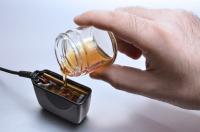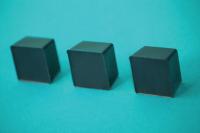
Liquid coating systems feature high performance and easy processing. Epoxy, polyurethane and polysulfide systems offer solutions to maximize protection against hostile environmental conditions. This includes corrosion/erosion, wear/abrasion, cavitation and chemical attack. These products are engineered to meet the demanding requirements of the transportation, appliance, defense, utility, food processing, oil/gas and electrical equipment industries.
Epoxies are the system of choice in many critical industrial coating applications. They provide optimum protection against large/fine particle abrasion, turbulence, cavitation, corrosive fluids, high/low temperatures, impact and compressive forces. Master Bond formulations exhibit outstanding durability, batch to batch consistency, excellent color replication and convenient cure schedules. They are designed to save time and energy, increase productivity and meet exact customer specifications. These products are solvent-free and environmentally friendly. Application efficiency is emphasized to improve cost effectiveness.
Selection Criteria for Industrial Coatings
When selecting a suitable coating system, a number of engineering and processing variables must be taken into consideration. Different coating types, and application methods, are recommended to best meet customer specifications and end use performance needs. These liquid compositions consisting of epoxies, silicones, urethane modified epoxy hybrids, polysulfides and UV/visible light curing systems are job proven for indoor/outdoor environments, and on diverse substrates such as metals, ceramics, and plastics.
Some common service conditions that should be examined when choosing an appropriate coating range from resistance to abrasion, wear, corrosion, oxidation, UV, water, moisture, mold, mildew, chemical attack, impact, vibration, shock, fire retardancy and high/low temperatures. These environmentally friendly systems contain no solvents and have low shrinkage upon cure. They are simple, safe to apply and possess high mechanical strength characteristics. Select grades will guard against extreme temperatures for intermittent and long term time periods. Other compositions are designed to withstand concentrated acids, alkalis, and solvents. These products have been used successfully for fumes, spillage, immersion, exposure and have solved difficult manufacturing problems. Additionally, proprietary, high quality, custom formulas have performed extremely well against abrasion and have mitigated excessive wear condition.
Requirements for Successful Coating Applications
Surface preparation plays a vital role in the product functionality, and it is critical that the surfaces are properly prepared prior to applying the coating. Viscosity, mixing of two part systems, working life, cure schedules and shelf life are also indispensible to the selection process. Often accomplished manually or automatically, final thickness of the coating can be affected when it is cured at ambient or elevated temperatures. A controlled curing environment is recommended for reproducible results and optimizing quality control. When mixing two part systems, blending the resin and hardener should be done thoroughly, at the exact mix ratio. It may be necessary to degas the mixture to avoid air entrapment or bubbles. Systems that exhibit long working life enable operators to mix larger size batches without rushing, and provide the flexibility of allowing an additional time period to precisely apply the coating. These systems exhibit lower exotherm and very low shrinkage upon cure. Cure speeds vary widely between coatings. Faster curing coatings are often used in high volume assembly to expedite output.
New Developments for Industrial Coating
Extensive research and development has enabled Master Bond to develop a wide range of compounds that provide unique solutions for manufacturing companies worldwide. It is important to note that Master Bond has introduced new UV nanosilica filled coating systems. These materials possess a low coefficient of thermal expansion, high Tg, exceptional dimensional stability, superior abrasion resistance and high optical clarity. These single component products have cure speeds in seconds, depending on the depth of the cure. Linear shrinkage is <1%.
Common Application Techniques:
- Brushing
- Roller coating
- Flow coating
- Dipping
- Spraying
- Spatula
- Robotic dispensing
Most Popular Industrial Coating Systems
 |
EP41S-1 Easily processable, two part epoxy with excellent chemical resistance, particularly to solvents. Available in black. 100% reactive. Low viscosity. Ambient temperature cure. Service temperature range from -60°F to +300°F. |
 |
EP62-1 Cures rapidly at moderate elevated temperatures. Superior resistance to moisture. Two part epoxy has long pot life at ambient temperatures. High bond strength properties. Reliable electrical insulator. Serviceable from -60°F to +450°F. Withstands aggressive chemical exposure. Tg 160-165°C. Shore D hardnes >80. |
 |
EP62-1LO Long working life. Cures quickly at moderate temperatures. Passes NASA low outgassing requirements. T >170°C. Resists exposure to acids, bases, many solvents and other chemicals. Superior bond strength properties. Service operating temperature range from -60°F to +450°F. |
 |
EP41S-1HT Two component, ambient temperature curing system with excellent physical properties. Thermally stable. High compressive strength. Features extraordinary resistance to fuels, alcohols and organic solvents. Withstands 1,000 hours 85°C/85% RH. Service temperature range -60°F to +400°F. Moderate viscosity. Good electrical insulator. |
 |
UV22DC80-10F Dual cure system with UV and heat curing mechanisms. Fast cures at 80°C in shadowed out areas. Nano filled, high dimensional stability and abrasion resistance. Bonds well to metals, glass, ceramics and most plastics. Minimal shrinkage upon curing. Serviceable from -60°F to +350°F. |
 |
EP21ARLV Two part, room temperature curable epoxy system with superior resistance to inorganic acids. Low viscosity. Used for bonding, sealing, coating, encapsulation. Serviceable from -60°F to +250°F. 100% reactive compound. Excellent dielectric strength. Especially noteworthy is its resistance to sulfuric and hydrochloric acids. |
 |
EP41S-F Fast room temperature curing epoxy system. Impressive chemical resistance. Superior electrical insulation properties. 100% reactive. Minimal shrinkage upon cure. Well suited for small sized encapsulating applications. Convenient processing. Service temperature range -60°F to +250°F. |
 |
EP45HTAN Thermally conductive/eletrically insulative epoxy serviceable from 4K to +500°F. Heat curing. Excellent strength retention at high temperatures. High dimensional stability and low shrinkage upon cure. Superior chemical resistance properties. |
